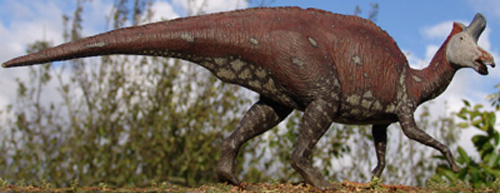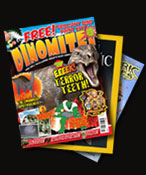Rareresource
Monday, January 26, 2009
Marine reptiles - for example, plesiosaurs and ichthyosaurs - were dinosaurs
Several types of marine reptiles evolved during the dinosaur age, but all true dinosaurs were terrestrial animals. Marine crocodiles, like other crocodiles, were closely related to the dinosaurs. So were large, extinct marine reptiles called plesiosaurs, pliosaurs, mosasaurs and ichthyosaurs.
Flying reptiles were dinosaurs
Flying reptiles called pterosaurs first appeared just after the dinosaurs, and then died out at the same time as the dinosaurs. The largest grew to the size of a small aeroplane. However, while they were close relatives, they were not true dinosaurs.
Tuesday, January 20, 2009
An asteroid impact alone killed the dinosaurs
A layer of iridium-rich rock marks the impact 65 million years ago of a 10-kilometre asteroid in shallow water covering what is now Mexico's Yucatan peninsula. That impact formed the 180 kilometre-wide Chicxulub crater. There is no convincing evidence that any non-avian dinosaurs survived the aftermath of the impact. Yet we are still not totally sure how the dinosaurs died.
The impact itself could only have killed the dinosaurs in the immediate vicinity of the crater. But it also produced devastating after-effects including giant tsunamis, rain that may have been as acidic as battery acid, and clouds of dust that darkened and cooled the globe for months or even decades.
Another theory suggests that before the impact, dinosaurs were already dwindling as falling sea levels and volcanic eruptions took their toll. A combination of those effects probably wiped out the dinosaurs.
Dinosaurs died out because mammals ate their eggs
Dinosaurs coexisted with mammals for 150 million years. Although dinosaur nests were undoubtedly vulnerable, the most dangerous predators were probably smaller dinosaurs. Most mammals of the time were probably too small to eat the eggs of large dinosaurs.
Sunday, January 18, 2009
A Smoking Gun for Dinosaur Extinction
It is hard to imagine that one of the largest impact craters on Earth, 180-kilometers (112-mile) wide and 900-meters (3,000-feet) deep, could all but disappear from sight, but it did.
Chicxulub, located on Mexico's Yucatan peninsula, eluded detection for decades because it was hidden (and at the same time preserved) beneath a kilometer of younger rocks and sediments. Size isn't the only thing that makes Chicxulub special. Most scientists now agree it's the "smoking gun" evidence that a huge asteroid or comet indeed crashed into Earth's surface 65 million years ago causing the extinction of more than 70 percent of the living species on the planet, including the dinosaurs. This idea was first proposed by the father and son team of Luis and Walter Alvarez in 1980.
Though the buried giant can't be seen, the impact crater has left subtle clues of its existence on the surface. "When I talk to school children, I describe it like this," says Dr. Gary Kinsland, a geology professor at the University of Louisiana at Lafayette who has been doing research on Chicxulub since 1994. "Put a bowl on your bed, then throw the sheets and blankets over it. All you'll probably see of the bowl now is a subtle depression."
"There is not a big hole anymore," he continues, "but if you look at the rim of the depression on your bed, you'll see that it is still in the same position as the rim of the bowl beneath. That's how surface expression allows us to interpret something about the buried structure."
The view from space lets scientists see some of Chicxulub's surface features that are not nearly so obvious from the ground. Satellite images showing a necklace of sink holes, called cenotes, across the Yucatan's northern tip are what first caught the attention of NASA researchers Drs. Kevin Pope, Adriana Ocampo and Charles Duller in 1990. They were among the first to propose Chicxulub as the impact site linked to the mass extinctions that occurred at the end of the Cretaceous and beginning of the Tertiary geological ages, called the K/T boundary.
For more information : http://www.jpl.nasa.gov/news/features.cfm?feature=8
Tuesday, January 6, 2009
Mammals only evolved after dinosaurs died out
Mammals remained relatively small until 65 million years ago, when the demise of the dinosaurs left a mass of niches for larger mammals to fill. Most of the types of mammals we know today evolved after this time.



